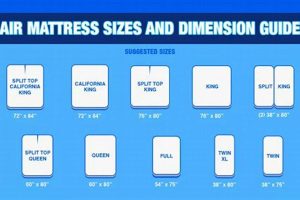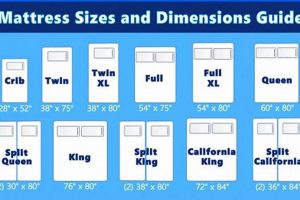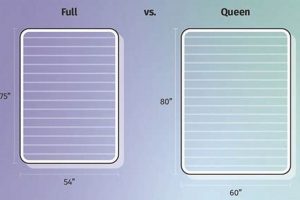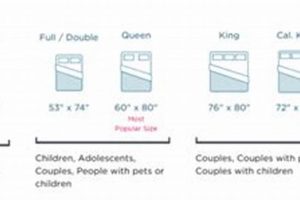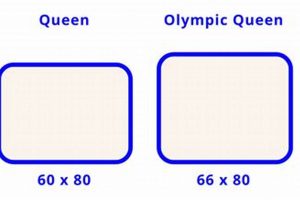The measurements of a recreational vehicle (RV) queen sleeping surface typically differ from a standard residential queen. This variance is crucial for ensuring a proper fit within the often-compact confines of these mobile living spaces. For example, a residential queen is 60 inches wide by 80 inches long; however, an RV queen may measure 60 inches wide by 75 inches long, or even have more customized dimensions depending on the RV model and manufacturer.
Understanding these specific measurements is paramount to selecting the correct sleeping arrangement for comfort and space optimization. A correctly sized sleeping surface avoids wasted space, allowing for more efficient use of the RV’s interior. Historically, RV sleeping surfaces were often standardized to maximize production efficiency. Today, the availability of various sizes acknowledges the increasing demand for comfort and customization in RV travel.
Therefore, when selecting a replacement or upgrading a recreational vehicle sleeping arrangement, it is essential to accurately measure the available space. This will dictate the appropriate size and shape, allowing for a comfortable and functional sleeping area without compromising the RV’s overall design and usability. Further considerations include mattress material, thickness, and overall comfort level.
Essential Considerations for Recreational Vehicle Sleeping Surfaces
Selecting the appropriate sleeping surface for an RV requires careful attention to detail. The following tips offer guidance in ensuring comfort, functionality, and optimal space utilization.
Tip 1: Precise Measurement is Critical: Prior to purchase, accurately measure the available space within the RV’s designated sleeping area. Account for any built-in cabinetry or structural limitations that may affect mattress fit.
Tip 2: Verify Actual Dimensions: Recognize that “RV Queen” is a general term and dimensions may vary significantly between manufacturers. Always consult the specific product specifications to confirm compatibility.
Tip 3: Consider Mattress Thickness: Assess the impact of mattress thickness on headroom and overall accessibility within the RV. A thicker mattress may provide greater comfort but could restrict movement or access to overhead compartments.
Tip 4: Evaluate Mattress Material: Explore different mattress materials, such as memory foam, innerspring, or latex, based on individual comfort preferences and support needs. Each material offers unique properties related to pressure relief, temperature regulation, and durability.
Tip 5: Assess Weight Considerations: Account for the weight of the sleeping surface, particularly when selecting a replacement. Excessive weight can impact fuel efficiency and potentially compromise the RV’s load-bearing capacity.
Tip 6: Evaluate the Base Support: Examine the quality and condition of the existing bed platform or support structure. Ensure it is structurally sound and capable of adequately supporting the chosen mattress to prevent premature wear or sagging.
Tip 7: Don’t forget about sheets: Once the mattress is found to meet requirements, consider RV queen sized sheets to complement the new mattress.
By adhering to these guidelines, individuals can confidently select a sleeping surface that maximizes comfort, optimizes space, and enhances the overall RV experience. Prioritizing accurate measurements, material evaluation, and weight considerations will ensure long-term satisfaction and prevent costly mistakes.
With the understanding of key factors in the RV sleeping surface selection, the decision-making process can be streamlined, leading to a more enjoyable and restful travel experience.
1. Width specifications
Width specifications are a critical element in the selection of a recreational vehicle (RV) queen sleeping surface. Deviations from expected width measurements can lead to significant fitment issues within the confined spaces typical of RVs. Understanding these specifications is therefore paramount for ensuring a comfortable and functional sleeping area.
- Standard vs. Actual Width
While the term “RV queen” suggests a standardized width, in practice, the actual width can vary by several inches between manufacturers. This discrepancy arises from the need to accommodate different RV floor plans and structural constraints. A mattress advertised as an RV queen may measure slightly less than or more than the expected 60 inches, necessitating precise measurement of the available space before purchase.
- Impact on Walkways and Accessibility
The width of the sleeping surface directly influences the available walkway space within the RV bedroom. An excessively wide mattress, even within the general parameters of an RV queen, can impede movement around the bed and restrict access to closets, drawers, or other essential storage areas. Careful consideration of the width specification is therefore crucial for maintaining functionality within the RV.
- Influence on Bedding Fit
Width specifications also dictate the appropriate size of bedding required for the RV queen mattress. Standard queen-sized sheets may not fit correctly on an RV queen mattress with non-standard width dimensions, leading to discomfort and potential damage to the bedding. Purchasing RV-specific or custom-sized bedding is often necessary to ensure a proper fit and maintain the mattress’s integrity.
- Considerations for Slide-Out Models
In RVs equipped with slide-out sections, the width of the sleeping surface may be further constrained by the dimensions of the slide-out. The width specification must account for the retracted position of the slide-out to ensure that the mattress does not impede its operation or create obstructions within the RV’s interior. Thoroughly assessing the slide-out’s dimensions is essential when determining the appropriate width for the RV queen mattress.
Ultimately, the width specification of an RV queen mattress is a pivotal factor influencing its suitability for a given RV. Meticulous measurement, awareness of potential variations, and consideration of the surrounding space are all essential to ensure that the selected mattress provides both comfort and functionality without compromising the RV’s overall design and usability. The relationship between dimensions and comfort cannot be overstated.
2. Length variations
Length variations within recreational vehicle (RV) queen sleeping surfaces are a significant deviation from standard residential mattress sizes, directly impacting both comfort and spatial efficiency. A typical residential queen mattress measures 80 inches in length. However, RV queen mattresses frequently exhibit shortened lengths, often measuring 75 inches, to accommodate the limited dimensions of RV bedrooms. This 5-inch difference, while seemingly minor, has considerable consequences. For taller individuals, it can lead to discomfort due to insufficient leg support, resulting in disrupted sleep. Furthermore, the reduced length allows RV manufacturers to optimize interior layouts, freeing up valuable floor space for other amenities. Failure to account for this variation during mattress selection invariably leads to either discomfort or an inability to properly install the mattress within the designated area.
The shortened length also influences the availability and fit of standard queen-sized bedding. Bedding designed for an 80-inch mattress will typically have excess material when used on a 75-inch RV queen mattress, creating a potential for bunching or requiring adjustments. This may necessitate the purchase of RV-specific or custom-sized sheets to ensure a proper and comfortable fit. Moreover, the reduced length frequently necessitates different sleeping positions or arrangements to compensate, affecting both the sleeper and those sharing the living space. Some RV models, particularly older ones, may feature even shorter or more unconventional lengths, compounding the difficulty in finding suitable replacement mattresses and bedding. Measuring with care is required.
In summary, length variations are a crucial element of RV queen mattress dimensions, directly influencing comfort, space utilization, and bedding compatibility. The reduced length, typically 75 inches compared to the standard 80 inches, requires careful consideration during mattress selection to avoid discomfort or installation problems. While it enables efficient space management within the RV, this dimensional difference necessitates awareness and potentially the acquisition of specialized bedding solutions. Accurate measurement and understanding of these variations are therefore paramount for a satisfactory RV sleeping experience.
3. Thickness tolerances
Thickness tolerances are a critical, albeit often overlooked, aspect of recreational vehicle (RV) queen sleeping surfaces. These tolerances, representing acceptable variations in mattress height, directly impact headroom, storage space, and overall comfort within the limited confines of an RV.
- Headroom Restrictions
Thickness directly correlates with available headroom. Exceeding the specified thickness tolerance can significantly reduce the distance between the mattress and the ceiling, leading to discomfort, particularly in RV models with low roof profiles. Reduced headroom can also impact ease of movement within the sleeping area.
- Storage Space Reduction
Many RVs incorporate under-bed storage compartments. Excessive mattress thickness diminishes the usable volume within these compartments, reducing the capacity for storing bedding, personal items, or other travel necessities. Maintaining appropriate thickness tolerances is, therefore, essential for preserving storage functionality.
- Bed Frame Compatibility
RV bed frames and support structures are designed to accommodate a specific range of mattress thicknesses. Selecting a mattress outside of these tolerances can lead to improper support, premature wear, or even structural damage to the bed frame itself. Frame incompatibility may manifest as sagging, uneven weight distribution, or instability during use.
- Accessibility Issues
Increased mattress thickness can negatively affect accessibility, especially for individuals with mobility limitations. A thicker mattress raises the sleeping surface, making it more difficult to get in and out of bed. This consideration is particularly relevant for RV travelers with age-related or physical challenges.
Therefore, meticulous attention to thickness tolerances is paramount when selecting an RV queen mattress. Failure to adhere to these specifications can compromise headroom, storage capacity, bed frame integrity, and overall accessibility, ultimately detracting from the RV travel experience. Precise measurement and verification of manufacturer specifications are critical steps in ensuring a compatible and comfortable sleeping arrangement.
4. Corner shape
Corner shape, as a component of recreational vehicle (RV) queen sleeping surfaces, directly influences the mattress’s ability to conform to the interior layout of the vehicle. Unlike standard residential mattresses, RV mattresses frequently feature modified corners, such as rounded or clipped shapes, to accommodate wheel wells, built-in cabinetry, or other structural elements within the typically compact RV bedroom. A square-cornered mattress, even of appropriate width and length, may not fit properly in a space designed for a clipped-corner model, leading to installation difficulties and inefficient space utilization. For instance, an RV with a rear wheel well intruding into the sleeping area necessitates a mattress with corresponding corner cuts to ensure a flush fit against the surrounding walls.
The practical significance of understanding corner shape variations is evident in avoiding costly purchasing errors. If the RV’s sleeping platform incorporates rounded corners, attempting to install a square-cornered mattress will result in gaps and an awkward fit. These gaps not only reduce the usable sleeping surface but also create opportunities for items to fall between the mattress and the wall, exacerbating cleaning challenges and potentially damaging the RV’s interior. Moreover, the incorrect corner shape can impede the proper functioning of slide-out mechanisms or interfere with access to storage compartments located beneath or adjacent to the bed.
In summary, corner shape is a critical dimension to consider when selecting an RV queen mattress, directly affecting fit, space utilization, and overall comfort. Ignoring corner shape requirements can lead to installation problems, reduced sleeping space, and operational impediments within the RV. Therefore, precise measurement and careful assessment of corner requirements are essential for ensuring a satisfactory and functional sleeping arrangement within the constraints of the RV’s interior design. Correct dimensions are essential.
5. Weight capacity
The weight capacity rating of a recreational vehicle (RV) queen sleeping surface is intrinsically linked to its dimensions and the materials used in its construction. Exceeding the specified weight limit can compromise the integrity of both the mattress and the underlying support structure.
- Material Density and Weight Distribution
Higher-density materials, such as memory foam or latex, generally contribute to a greater overall mattress weight for a given set of dimensions. This increase in weight must be factored into the RV’s total load-bearing capacity. Furthermore, uneven weight distribution across the mattress, particularly with heavier individuals or couples, can concentrate stress points and accelerate wear, potentially exceeding localized weight limits.
- Frame and Support Structure Limitations
The frame supporting the RV queen mattress is designed to accommodate a specific maximum weight. The dimensions of the mattress influence how this weight is distributed. A larger or thicker mattress, even within acceptable RV queen dimensions, will exert greater stress on the frame. Exceeding the frame’s capacity can result in structural damage, sagging, or even complete failure, compromising both safety and comfort. The type of materials used on the frame is also a key contributing factor.
- Impact on RV’s Overall Weight Rating
The weight of the RV queen mattress contributes to the overall weight of the recreational vehicle, which is subject to strict legal limitations. Overloading an RV can result in reduced fuel efficiency, impaired handling, and increased risk of accidents. Careful consideration of the mattress weight, in relation to its dimensions, is crucial for staying within the RV’s gross vehicle weight rating (GVWR) and ensuring safe operation. Therefore, every component that contributes to weight becomes essential.
- Long-Term Durability and Sagging
Consistent overloading of the RV queen mattress, even if momentarily tolerated by the support structure, will accelerate wear and tear. Over time, this can lead to premature sagging, loss of support, and reduced comfort. The dimensions of the mattress, combined with its construction, influence its susceptibility to sagging under heavy loads. This makes understanding the specifications of the mattress essential.
The interconnection between weight capacity and recreational vehicle queen mattress dimensions necessitates a holistic approach. The mattress’s dimensions, construction materials, and the RV’s frame limitations must be carefully considered to ensure a safe, comfortable, and durable sleeping arrangement that complies with weight regulations. Failing to address weight considerations can lead to structural damage, safety hazards, and a diminished RV experience.
Frequently Asked Questions
This section addresses common inquiries and clarifies key aspects related to RV queen mattress dimensions, emphasizing the importance of accuracy and compatibility for optimal comfort and safety.
Question 1: Are recreational vehicle queen mattress dimensions identical to standard residential queen dimensions?
No. RV queen mattresses typically deviate from standard residential queen dimensions, often being shorter in length (75 inches versus 80 inches) to accommodate the limited space within RV bedrooms. Widths can also vary. Precise measurements are essential.
Question 2: Where can I locate exact dimensions for a specific RV queen mattress?
Consult the product specifications provided by the mattress manufacturer or retailer. These specifications should explicitly state the mattress’s length, width, and thickness. If this information is not readily available, contacting the manufacturer directly is advisable.
Question 3: What implications do mattress thickness tolerances have on RV queen sleeping arrangements?
Mattress thickness affects headroom, storage space within the RV, and compatibility with bed frames. Exceeding thickness tolerances can reduce headroom, diminish storage capacity, and compromise bed frame integrity. Adhering to specified tolerances is crucial.
Question 4: Why are corner shapes a critical factor in recreational vehicle queen mattress selection?
RV mattresses frequently incorporate modified corner shapes (e.g., rounded or clipped) to accommodate wheel wells or built-in cabinetry within the RV’s interior. A mismatch between the mattress corner shape and the RV’s design can lead to installation difficulties and inefficient space utilization. Accurate assessment is imperative.
Question 5: How does mattress weight impact the overall performance of a recreational vehicle?
Mattress weight contributes to the RV’s gross vehicle weight rating (GVWR). Exceeding the GVWR can reduce fuel efficiency, impair handling, and increase the risk of accidents. Selecting a mattress that aligns with the RV’s weight limitations is essential for safe operation.
Question 6: What strategies can be employed to ensure the correct fit of an RV queen mattress?
Prioritize precise measurement of the available space within the RV’s sleeping area. Account for any structural limitations or built-in cabinetry. Verify the actual dimensions of the mattress before purchase, consulting product specifications and contacting the manufacturer if necessary.
Understanding these frequently asked questions regarding RV queen mattress dimensions facilitates informed decision-making, promotes optimal comfort, and ensures compatibility with the vehicle’s specifications.
The next section will focus on recommended maintenance practices to ensure the longevity of RV queen mattresses.
RV Queen Mattress Dimensions
The preceding analysis has underscored the critical nature of understanding recreational vehicle queen sleeping surface measurements. Variations in width, length, thickness, and corner shape directly impact compatibility and comfort within the typically constrained environment of an RV. Adherence to weight capacity limits is essential for safety and operational efficiency. The data presented highlights the need for meticulous measurement and careful consideration of manufacturer specifications.
Ultimately, informed selection and proper installation of an RV queen mattress depend on a comprehensive understanding of its dimensional properties. Neglecting these factors can lead to compromised comfort, reduced storage space, and potential structural damage. A thorough evaluation of the factors discussed remains crucial for ensuring a safe, comfortable, and functional sleeping arrangement, thus enhancing the overall recreational vehicle experience. Continued research into advanced materials and ergonomic designs promises future improvements in RV mattress technology, further emphasizing the need for ongoing awareness and education within the industry.


